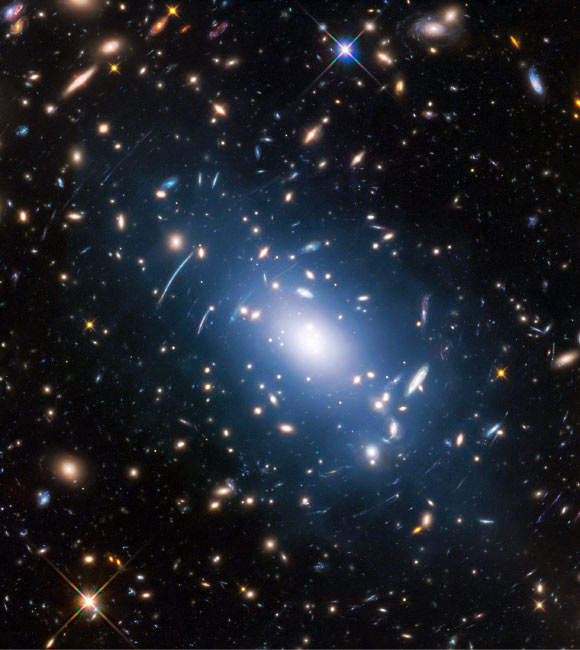Dark matter is a mysterious substance that makes up about 85% of the matter in the Universe. It does not emit any kind of electromagnetic radiation and its presence can only be determined via gravitational effects. In recent years scientists have tried to understand its true nature and map its distribution in the Universe. Now a team of astronomers has used data from the Hubble Frontier Fields Program to accurately study the distribution of dark matter in massive galaxy clusters.

The galaxy cluster Abell S1063 was observed by the NASA/ESA Hubble Space Telescope as part of the Frontier Fields Program. The huge mass of the cluster — containing both baryonic matter and dark matter — acts as cosmic magnification glass and deforms objects behind it. In the past astronomers used this gravitational lensing effect to calculate the distribution of dark matter in galaxy clusters. A more accurate and faster way, however, is to study the intracluster light (visible in blue), which follows the distribution of dark matter. Image credit: NASA / ESA / M. Montes, University of New South Wales.
Utilizing Hubble’s past observations of six massive galaxy clusters in the Frontier Fields Program, the team demonstrated that intracluster light — the diffuse glow between galaxies in a cluster — traces the path of dark matter, illuminating its distribution more accurately than existing methods that observe X-ray light.
“The Hubble Frontier Fields showed intracluster light in unprecedented clarity. The images were inspiring,” said Dr. Ignacio Trujillo, an astronomer at the Canary Islands Institute of Astronomy.
“Still, I did not expect the results to be so precise. The implications for future space-based research are very exciting.”
Intracluster light is a byproduct of interactions between galaxies.
In the course of these interactions, individual stars are stripped from their galaxies and float freely within the cluster. Once free from their galaxies, they end up where the majority of the mass of the cluster, mostly dark matter, resides.
“These stars have an identical distribution to the dark matter, as far as our current technology allows us to study,” said Dr. Mireia Montes, a researcher at the University of New South Wales, Australia.
Both the dark matter and these isolated stars act as collisionless components. These follow the gravitational potential of the cluster itself.
“We found that the intracluster light is aligned with the dark matter, tracing its distribution more accurately than any other method relying on luminous tracers used so far. This method is also more efficient than the more complex method of using gravitational lensing,” the researchers said.
“While the latter requires both accurate lensing reconstruction and time-consuming spectroscopic campaigns, the method utilizes only deep imaging. This means more clusters can be studied with the new method in the same amount of observation time.”
The results introduce the possibility of exploring the ultimate nature of dark matter.
“If dark matter is self-interacting we could detect this as tiny departures in the dark matter distribution compared to this very faint stellar glow,” Dr. Trujillo said.
The study is published in the Monthly Notices of the Royal Astronomical Society (arXiv.org preprint).
_____
Mireia Montes & Ignacio Trujillo. 2019. Intracluster light: a luminous tracer for dark matter in clusters of galaxies. MNRAS 482 (2): 2838-2851; doi: 10.1093/mnras/sty2858







